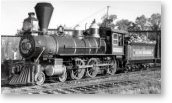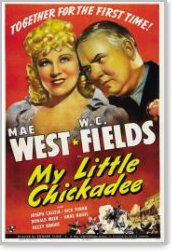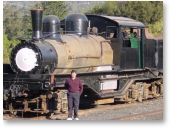 In the late 1800s, a New York railroader named Thomas S. Bullock had the foresight to recognize the need for a railroad to serve the Sierra Nevada foothill communities of Tuolumne and Calaveras counties. In addition to handling local freight and passengers, Bullock also saw the potential for large profits in shipping ore, lumber, and cattle. His vision was shared by Prince Andre Poniatowski, a French-born descendant of the King of Poland. Poniatowski convinced banker William H. Crocker to provide the needed financial backing for the project, and on February 1, 1897, the Sierra Railway Company of California was formally incorporated.
In the late 1800s, a New York railroader named Thomas S. Bullock had the foresight to recognize the need for a railroad to serve the Sierra Nevada foothill communities of Tuolumne and Calaveras counties. In addition to handling local freight and passengers, Bullock also saw the potential for large profits in shipping ore, lumber, and cattle. His vision was shared by Prince Andre Poniatowski, a French-born descendant of the King of Poland. Poniatowski convinced banker William H. Crocker to provide the needed financial backing for the project, and on February 1, 1897, the Sierra Railway Company of California was formally incorporated.
Grading for the new railroad initially began in Oakdale. Much of the equipment and rail used in its construction came from Bullock's defunct Prescott and Arizona Central Railroad, which had become unprofitable after Santa Fe built a track parallel to it.
 Approximately 50 acres were acquired from G.A. Leland to accommodate the yards, roundhouse, shops, water tanks, fuel storage and depot, which also housed the company's general offices. On November 8, 1897, the Sierra’s first passenger train arrived in Jamestown. A year later, the line was extended four miles and the railroad's terminus was moved to Sonora. In 1900, another 12 miles were added to Tuolumne City. A 19-mile branch was completed to Angels Camp in 1902, which served neighboring Calaveras County until 1935. Other temporary branches were also built to haul construction equipment and materials for dams on the Stanislaus and Tuolumne Rivers. For years, the Sierra Railway continued to move goods between the San Joaquin Valley floor at Oakdale and the foothills of Tuolumne County.
Approximately 50 acres were acquired from G.A. Leland to accommodate the yards, roundhouse, shops, water tanks, fuel storage and depot, which also housed the company's general offices. On November 8, 1897, the Sierra’s first passenger train arrived in Jamestown. A year later, the line was extended four miles and the railroad's terminus was moved to Sonora. In 1900, another 12 miles were added to Tuolumne City. A 19-mile branch was completed to Angels Camp in 1902, which served neighboring Calaveras County until 1935. Other temporary branches were also built to haul construction equipment and materials for dams on the Stanislaus and Tuolumne Rivers. For years, the Sierra Railway continued to move goods between the San Joaquin Valley floor at Oakdale and the foothills of Tuolumne County.
As the nation became more mechanized, paved roads became prevalent and railroads, including the Sierra Railway, struggled for existence. As fate would have it, the end of the railroad era coincided with the beginning of another - the growth of the motion picture industry. Because of its superb scenery, movie producers singled out the Sierra as a preferred film location, and consequently, the railway that was built in 1897 as a 57-mile common carrier came to be known as “The Movie Railroad.” In time, more than 200 movies, television productions, and commercials would be made using the Sierra and its historic fleet of steam locomotives, making it one of the most recognizable railroads in the world.
 Railtown 1897 State Historic Park is located in the City of Jamestown, in Tuolumne County, the heart of California's Gold Country, and is the home of the Historic Sierra Railroad Shops
and Roundhouse. The Railtown 1897 Interpretive Center combines railroad history with the lore and glamour of Hollywood's film industry, highlighting the fact that the locomotive, as an icon of American progress and industrial might, has made the railroad an essential element of both motion pictures and television. It is believed that the Sierra Railroad’s first appearance in a film was for the train holdup scene in Universal Pictures' silent serial The Red Glove (1919). Additionally, one of the Sierra locomotives became the first train used in a “talkie” when it was utilized in Paramount’s The Virginian (1929), the film adaptation of Owen Wister’s famous novel, starring Gary Cooper and Walter Huston.
Railtown 1897 State Historic Park is located in the City of Jamestown, in Tuolumne County, the heart of California's Gold Country, and is the home of the Historic Sierra Railroad Shops
and Roundhouse. The Railtown 1897 Interpretive Center combines railroad history with the lore and glamour of Hollywood's film industry, highlighting the fact that the locomotive, as an icon of American progress and industrial might, has made the railroad an essential element of both motion pictures and television. It is believed that the Sierra Railroad’s first appearance in a film was for the train holdup scene in Universal Pictures' silent serial The Red Glove (1919). Additionally, one of the Sierra locomotives became the first train used in a “talkie” when it was utilized in Paramount’s The Virginian (1929), the film adaptation of Owen Wister’s famous novel, starring Gary Cooper and Walter Huston.
Over the years, a wide diversity of films has been lensed on the Sierra Railroad, including Warner Brothers' entertaining large-scale Technicolor Dodge City (1939) starring Errol Flynn and Olivia De Havilland; Universal Pictures' Western satire My Little Chickadee (1940) starring Mae West and W.C. Fields, both of whom collaborated on the screenplay;
 David O. Selznick's ambitious attempt to duplicate his GWTW success, Duel in the Sun (1946) starring Jennifer Jones and Gregory Peck; Stanley Kramer's Oscar-winning, crisis-of-conscience Western drama High Noon (1952) starring Gary Cooper and Grace Kelly; Blake Edwards' Panavision comedy The Great Race (1965) starring Tony Curtis and Jack Lemmon; 20th Century Fox's slapstick farce The World's Greatest Lover (1977) directed by Gene Wilder, who also starred along with Carol Kane and Dom De Luise; Robert Zemeckis’ comedy sci-fi time-travel trilogy conclusion Back to the Future III (1990) starring Michael J. Fox and Christopher Lloyd; and Richard Friedman's sentimental drama Redemption of the Ghost (2002) starring Diane Ladd and John Savage. Other major Hollywood stars to have played a part in the Sierra Railroad's storied past include Mabel Normand, William S. Hart, John Wayne, Michael Landon, Clint Eastwood and Drew Barrymore. Television entries to be transported on the Sierra Railroad over the years include Rawhide, Death Valley Days, The Big Valley, Petticoat Junction, Green Acres, The Wild Wild West, Iron Horse, Gunsmoke, Bonanza and Little House on the Prairie.
David O. Selznick's ambitious attempt to duplicate his GWTW success, Duel in the Sun (1946) starring Jennifer Jones and Gregory Peck; Stanley Kramer's Oscar-winning, crisis-of-conscience Western drama High Noon (1952) starring Gary Cooper and Grace Kelly; Blake Edwards' Panavision comedy The Great Race (1965) starring Tony Curtis and Jack Lemmon; 20th Century Fox's slapstick farce The World's Greatest Lover (1977) directed by Gene Wilder, who also starred along with Carol Kane and Dom De Luise; Robert Zemeckis’ comedy sci-fi time-travel trilogy conclusion Back to the Future III (1990) starring Michael J. Fox and Christopher Lloyd; and Richard Friedman's sentimental drama Redemption of the Ghost (2002) starring Diane Ladd and John Savage. Other major Hollywood stars to have played a part in the Sierra Railroad's storied past include Mabel Normand, William S. Hart, John Wayne, Michael Landon, Clint Eastwood and Drew Barrymore. Television entries to be transported on the Sierra Railroad over the years include Rawhide, Death Valley Days, The Big Valley, Petticoat Junction, Green Acres, The Wild Wild West, Iron Horse, Gunsmoke, Bonanza and Little House on the Prairie.
In 1982, the Sierra Railroad’s 26-acre site was purchased by the State of California for inclusion in the State Park System, thus preserving one of North America's last operating steam era railroad facilities. On July 1, 1992, the California State Railroad Museum (CSRM), headquartered in Old Sacramento,
 assumed responsibility for Railtown 1897 State Historic Park. The Museum Complex alone encompasses a wide variety of facilities including the Museum of Railroad History and Library, the Eagle Theatre, the 1849 Scene, the Central Pacific Railroad Passenger Station, and the Sacramento Southern Railroad, which over the years has also played a significant role in the movies and television. Silver screen credits for the Sacramento Southern include Fox Film's The Iron Horse (1924), the epic silent film about the building of the transcontinental railroad, starring George O'Brien and Madge Bellamy; Cecil B. De Mille's saga about the building of the first transcontinental railroad, Union Pacific (1939) starring Barbara Stanwyck and Joel McCrea; Republic Pictures' story about stagecoach line resistance towards railroad expansion, Rock Island Trail (1950) starring Forrest Tucker and Adele Mara;
assumed responsibility for Railtown 1897 State Historic Park. The Museum Complex alone encompasses a wide variety of facilities including the Museum of Railroad History and Library, the Eagle Theatre, the 1849 Scene, the Central Pacific Railroad Passenger Station, and the Sacramento Southern Railroad, which over the years has also played a significant role in the movies and television. Silver screen credits for the Sacramento Southern include Fox Film's The Iron Horse (1924), the epic silent film about the building of the transcontinental railroad, starring George O'Brien and Madge Bellamy; Cecil B. De Mille's saga about the building of the first transcontinental railroad, Union Pacific (1939) starring Barbara Stanwyck and Joel McCrea; Republic Pictures' story about stagecoach line resistance towards railroad expansion, Rock Island Trail (1950) starring Forrest Tucker and Adele Mara;
 Walt Disney's treatment of Eleanor Porter's comedy story Pollyanna (1960) starring Hayley Mills and Jane Wyman; Billy Wilder's Panavision comedy drama The Front Page (1974) starring Jack Lemmon and Walter Matthau, his third filming of the Ben Hecht and Charles MacArthur play about Chicago newspapermen in the 1920s; and, more recently, Warner Brothers' ill-fated attempt at reproducing the popular 1960s television series Wild Wild West (1999) starring Will Smith and Kevin Kline. A sampling of television appearances of the Sacramento Southern Railroad include Death Valley Days, Smithsonian World, The Real West, Dr. Quinn Medicine Woman, Modern Marvels, Trains Unlimited and Good Morning America.
Walt Disney's treatment of Eleanor Porter's comedy story Pollyanna (1960) starring Hayley Mills and Jane Wyman; Billy Wilder's Panavision comedy drama The Front Page (1974) starring Jack Lemmon and Walter Matthau, his third filming of the Ben Hecht and Charles MacArthur play about Chicago newspapermen in the 1920s; and, more recently, Warner Brothers' ill-fated attempt at reproducing the popular 1960s television series Wild Wild West (1999) starring Will Smith and Kevin Kline. A sampling of television appearances of the Sacramento Southern Railroad include Death Valley Days, Smithsonian World, The Real West, Dr. Quinn Medicine Woman, Modern Marvels, Trains Unlimited and Good Morning America.
Together, the Sierra and Sacramento Southern Railroads have become the most photographed railroads in the world. Thanks to the efforts of the California State Railroad Museum our locomotive historical past has been preserved for future generations to enjoy.